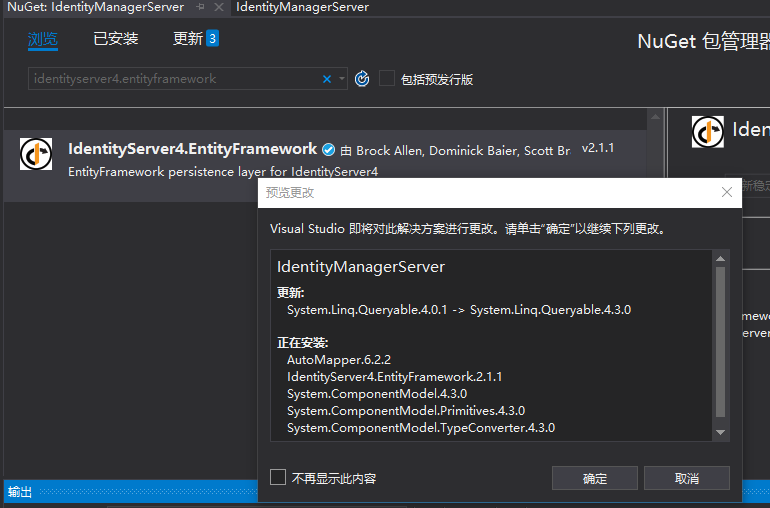在 使用 ASP.NET Core Identity 的 IdentityServer4 授权服务器 中,IdentityServer4 使用的是内存数据,不方便灵活,这次要把 IdentityServer4 的数据也保存到数据库中。
添加 IdentityServer4.EntityFramework
IdentityServer4 有两种类型的数据需要保存数据库中。第一是配置数据(资源和客户端),第二个是 IdentityServer 在使用时产生的操作数据(令牌,代码和同意)。这些存储使用接口建模, Nuget包中的 IdentityServer4.EntityFramework 提供这些接口的EF实现。
添加 IdentityServer4.EntityFramework 包

修改 Startup.cs
在 Startup.cs 的 ConfigureServices方法中添加以及修改以下代码:
var connectionString = Configuration.GetConnectionString("DefaultConnection");
var migrationsAssembly = typeof(Startup).GetTypeInfo().Assembly.GetName().Name;
services.AddIdentityServer()
.AddDeveloperSigningCredential()
//.AddInMemoryPersistedGrants()
//.AddInMemoryIdentityResources(Config.GetIdentityResources())
//.AddInMemoryApiResources(Config.GetApiResources())
//.AddInMemoryClients(Config.GetClients())
.AddConfigurationStore(options =>
{
options.ConfigureDbContext = builder =>
builder.UseMySQL(connectionString,
sql => sql.MigrationsAssembly(migrationsAssembly));
})
.AddOperationalStore(options =>
{
options.ConfigureDbContext = builder =>
builder.UseMySQL(connectionString,
sql => sql.MigrationsAssembly(migrationsAssembly));
// this enables automatic token cleanup. this is optional.
options.EnableTokenCleanup = true;
options.TokenCleanupInterval = 30;
})
.AddAspNetIdentity<ApplicationUser>();
添加迁移
在项目目录中打开命令提示符。在命令提示符下运行以下两个命令,一个是为了IdentityServer的配置,另一个是为了持久化授权:
dotnet ef migrations add InitialIdentityServerPersistedGrantDbMigration -c PersistedGrantDbContext -o Data/Migrations/IdentityServer/PersistedGrantDb
dotnet ef migrations add InitialIdentityServerConfigurationDbMigration -c ConfigurationDbContext -o Data/Migrations/IdentityServer/ConfigurationDb
注意事项:Ubuntu Server 16.04 自带源安装的是
MariaDB 10.0,执行第一个命令的时候会出现错误,请参考 安装 MariaDB 及远程连接设置 安装MariaDB 10.3或以上版本 ,以便能顺利执行这两个命令。
命令执行结果如以下显示:
PS D:source
eposIdentityManagerServerIdentityManagerServer> dotnet ef migrations add InitialIdentityServerPersistedGra
ntDbMigration -c PersistedGrantDbContext -o Data/Migrations/IdentityServer/PersistedGrantDb
info: Microsoft.AspNetCore.DataProtection.KeyManagement.XmlKeyManager[0]
User profile is available. Using 'C:UsersYodaAppDataLocalASP.NETDataProtection-Keys' as key repository and Windows DPAPI to encrypt keys at rest.
dbug: IdentityServer4.Startup[0]
Using Identity.Application as default scheme for authentication
dbug: IdentityServer4.Startup[0]
Using Identity.External as default scheme for sign-in
dbug: IdentityServer4.Startup[0]
Using Identity.External as default scheme for sign-out
dbug: IdentityServer4.Startup[0]
Using Identity.Application as default scheme for challenge
dbug: IdentityServer4.Startup[0]
Using Identity.Application as default scheme for forbid
info: Microsoft.EntityFrameworkCore.Infrastructure[10403]
Entity Framework Core 2.0.3-rtm-10026 initialized 'PersistedGrantDbContext' using provider 'MySql.Data.EntityFrameworkCore' with options: MigrationsAssembly=IdentityManagerServer
Done. To undo this action, use 'ef migrations remove'
PS D:source
eposIdentityManagerServerIdentityManagerServer> dotnet ef migrations add InitialIdentityServerConfiguratio
nDbMigration -c ConfigurationDbContext -o Data/Migrations/IdentityServer/ConfigurationDb
info: Microsoft.AspNetCore.DataProtection.KeyManagement.XmlKeyManager[0]
User profile is available. Using 'C:UsersYodaAppDataLocalASP.NETDataProtection-Keys' as key repository and Windows DPAPI to encrypt keys at rest.
dbug: IdentityServer4.Startup[0]
Using Identity.Application as default scheme for authentication
dbug: IdentityServer4.Startup[0]
Using Identity.External as default scheme for sign-in
dbug: IdentityServer4.Startup[0]
Using Identity.External as default scheme for sign-out
dbug: IdentityServer4.Startup[0]
Using Identity.Application as default scheme for challenge
dbug: IdentityServer4.Startup[0]
Using Identity.Application as default scheme for forbid
info: Microsoft.EntityFrameworkCore.Infrastructure[10403]
Entity Framework Core 2.0.3-rtm-10026 initialized 'ConfigurationDbContext' using provider 'MySql.Data.EntityFrameworkCore' with options: MigrationsAssembly=IdentityManagerServer
Done. To undo this action, use 'ef migrations remove'
执行以上命令显示结果为
Build failed.时,可以尝试先重新生成项目,然后再执行以上迁移命令。
初始化数据库
进行了迁移后,可以编写代码来从迁移中创建数据库。还可以将之前定义的内存配置数据来为数据库设定种子。在 Startup.cs 中添加一个用来进行初始化数据库的方法:
private void InitializeDatabase(IApplicationBuilder app)
{
using (var serviceScope = app.ApplicationServices.GetService<IServiceScopeFactory>().CreateScope())
{
serviceScope.ServiceProvider.GetRequiredService<PersistedGrantDbContext>().Database.Migrate();
var context = serviceScope.ServiceProvider.GetRequiredService<ConfigurationDbContext>();
context.Database.Migrate();
if (!context.Clients.Any())
{
foreach (var client in Config.GetClients())
{
context.Clients.Add(client.ToEntity());
}
context.SaveChanges();
}
if (!context.IdentityResources.Any())
{
foreach (var resource in Config.GetIdentityResources())
{
context.IdentityResources.Add(resource.ToEntity());
}
context.SaveChanges();
}
if (!context.ApiResources.Any())
{
foreach (var resource in Config.GetApiResources())
{
context.ApiResources.Add(resource.ToEntity());
}
context.SaveChanges();
}
}
}
从 Configure 方法调用它:
public void Configure(IApplicationBuilder app, IHostingEnvironment env, ILoggerFactory loggerFactory)
{
// this will do the initial DB population
InitializeDatabase(app);
// the rest of the code that was already here
// ...
}
再次运行程序,就可以将数据保存到数据库中了,我们可以通过数据库的客户端打开并看到写入到里面的内容:

InitializeDatabase方法并不适合每次运行应用程序时执行,填充数据库后,请考虑删除(或注释)对它的调用。